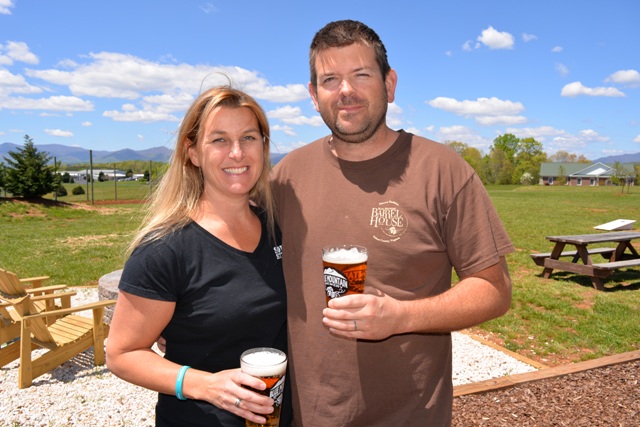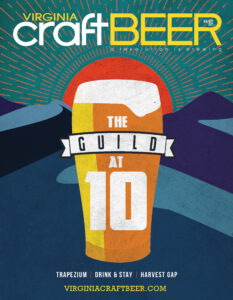By Jeff Maisey
For most couples, being married with two children tends to dominate life when multi-tasking to get the kids off to school or soccer practice while managing to put-in a 9-5 day at the job and get supper on the table before homework and bedtime.
So what happens then when you are married to your business partner and operate not one, not two, but THREE craft breweries?
Taylor and Mandi Smack were married in 2004. Today they have two young children and operate Blue Mountain Brewery (Afton, Virginia), Blue Mountain Barrel House (Arrington), and South Street Brewery (Charlottesville). Both Blue Mountain, in Afton, and South Street Brewery, in downtown Charlottesville, offer full service restaurants.
To learn more about their brewing business, which they began in 2007 with Matt Nucci, I caught up with the dynamic husband and wife duo at Blue Mountain Barrel House, the 30-barrel brew system using primarily 120-barrel tanks that are projected to produce 15,000 barrels this year.
VCB: Most brewery owners started as homebrewers. How did you decide to open Blue Mountain Brewery?
Taylor: I basically didn’t like my job out of college in the 1990s. I started volunteering at South Street Brewery in the ‘90s. I went up to Sieble Institute in Chicago. I met Mandi in 2000. I was working for Goose Island. After a while we decided to leave the city and came back down south. I brewed at South Street for 5-1/2 years. I had a business plan and wanted to do my own brewery. So we opened Blue Mountain in 2007 at the original location in Afton. We expanded, going from 8 employees to 90.
In 2012, our beer was in higher demand than we could fulfill so we opened Blue Mountain Barrel House. We employee another 25 people here.
Most recently we acquired South Street Brewery in July of 2014. As you can imagine it was like coming home for me. We have another 40 or 50 employees there.
Our interest in craft beer definitely predates the crazy boom. I came along at a time after the big hit in the 1990s. It was a weird time for craft beer. There was a big surge in the mid-90s with a bunch of bad contract brews saturating the market. Craft beer took a dive in the late 1990s. Everybody thought it was a fad. It is interesting now to see the sorta Golden Age and craft beer going up, up, up. I guess we’re like the dinosaurs of the industry.
Mandi: I’m from Wisconsin so I’ve been surrounded by beer my whole life. A lot of my relatives worked a G. Heileman Brewing Company. I went to school at Marquette in downtown Milwaukee. I went to breweries all the time when I was in college.
I met Taylor through a mutual friend that was working at Goose Island. I’ve always gravitated to craft beer even before it was “cool.” I moved to the Outer Banks from Chicago and sort of helped open the Outer Banks Brewing Station. I was one of their first employees when it was white tablecloth. It has shifted gears since then.
I also worked at South Street as a host and server. I did festivals and events for them even though I wasn’t on their payroll. It was a passion for me. And my boyfriend (Taylor) worked there.
In 2006, we came up with our business plan. We drove around numerous hours trying to find the right location for Blue Mountain.
VCB: I understand you first considered the Arrington site before opening in Afton. How did you arrive at your conclusion?
Taylor: We actually looked at this site (Arrington) with Fred Greenwald and Jack Landry – the then owners of South Street. I was pushing them to do a production brewery in 2003 because I saw the window was beginning to open for micro breweries in Virginia. We went with the co-op and the county who owned this industrial park. It has mountain views you just can’t beat. It is a good shipping location. It has access to city water.
When we opened Blue Mountain Brewpub in Afton it was a totally different mindset. We wanted to recreate what wineries had done in Virginia. I feel like we were the first ones to do that. Our whole business plan was a rural brewery model.
When we came back to this site (Arrington) in 2012 it was again revisiting the idea of production. We still don’t feel this is a great location to get the crowds we do up at Afton. In Afton, we’re right by Skyline Drive, Blue Ridge Parkway, Wintergreen. It is real accessible to Charlottesville. It’s by the wineries. Arrington is a thinner end of the county. Our return to this location was only to look at production.
VCB: The Afton location has a beautiful panoramic view of the mountains. But the view in Arrington is pretty impressive as well. Is it just coincidence the both Blue Mountain brewery locations have stunning mountain views?
Mandi: We kinda always looked for a great view. That was one of the driving forces for coming out to Nelson County. Since this location (Arrington) is geared to production it wasn’t a necessity, but people do come out here to relax and check out the views. It’s growing every day. It makes coming to work a lot easier.
Taylor: I think it’s good for the brewers’ sanity. When I come here every morning those mountains are in your face. In winter they are snow-capped. You can’t believe you’re in Virginia. You turn down this one little road (to the barrel house) and it is just panoramic views. At 9 or 10 in the morning with sun shining on them from the east, honestly, it beats our Afton view, and that’s hard to do because it’s beautiful there. You get chills when you come around that corner in the morning and it looks like the Rockies or something.
VCB: You are a husband and wife team and now running three breweries. Did you ever think you’d operate three locations? Do you have further expansion goals?
Taylor: We’re done for a little bit, but several times a year we get very serious offers from economic development representatives from all over the state. We’re considering one or two right now.
It’s definitely difficult. We have around 160 employees right now.
On the brewing side some of the things are easier. We have yeast, hops and barley contracts that we share between the breweries. It’s rare that we get caught without something. Any brewer will tell you it happens all the time when you’re a single brewery. So that side of the business is easier, but that’s like 10%. I would personally say everything else is difficult. Mandi and I are a positive style of micromanaging in that we are very involved. We live next to the Afton brewery. We can walk and drop what we’re doing. It’s constant involvement. It’s hectic. It’s interesting. I’m not sure many marriages can take it. But we feel really lucky to be great business partners as well as husband and wife.
Mandi: I think it is really unique to have the three different business models for breweries. It doesn’t matter if you have a slow week in the tasting room when your (packaged) distribution is skyrocketing. With South Street Brewpub, they don’t sell much off-site. All three balance each other.
VCB: Can you tell us about the bourbon barrel side of your business and why that is an important part of your product line?
Taylor: Barrel aging has always been part of my career. Bourbon barrel aging originated from Goose Island with Bourbon County Stout back in the mid-90s. When I was there it was just part of what I inherited. The Illinois Craft Brewers Guild was the only pocket in America that I knew of that was doing it.
When we did Barrel House we knew we wanted to explore that side a little more and start a full barrel program, and build a brewery to handle it in ways other breweries can’t. We have special cold rooms, racking areas, specialized equipment. We didn’t call it Barrel House by mistake. It was very well planned. We also use it to brew our core brands. I don’t think a lot of people know how extensive our barrel aging program is. I don’t know of anyone in Virginia who has 400 barrels filled and in rotation at any one time. That’s about what we run. I’ve got to think we’re one of the biggest barrel programs on the East Coast. We have things in barrels anywhere from 3 weeks to 2 years. Most of our product is in for 3 to 4 months. Some beers will only hit a barrel one time and others will get a second or third wash.
We have a sour program for beers. We can do smaller quantities of sour.
We have a special bottling line for our 750 milliliter cork and cage. We use fermenting beer to carbonate and condition instead of sugar and yeast so it has live beer. It’s really unique. We want to be A+ every time.
Right now we’re doing huge amounts of our Spooky pumpkin barrel-aged beer, our Chocolate Coffee Dark Hollow, our regular Dark Hollow, our two sour beers, and Local Species.
VCB: In Belgium, brewers that produce Lambic and Geuze are known to blend various aged beers. There are even specialized businesses that do nothing but blend beers, like a winery blends reds. Do you blend any of your barrel-aged beers?
Taylor: We don’t do it in the same way or for the same ends as those guys do. We’ll blend within 1, 2 or 3 batches across mainly for hop profile or age. We actually dry hop Local Species but we have a number of un-dry hop barrels so we have to hit that note right. That’s also a beer, because it’s lighter, when it’s in the barrels too long it can start to show so we have to blend it with younger beer. The flipside of that is Dark Hollow where you really can’t get in a rush with that beer. We tell our distributors they have to order that a long time out. We prefer for it to be in barrels 4 or 5 months.
VCB: One of the take-aways from the Craft Brewers Conference in Portland, Oregon was the advice that breweries need to focus more on their core, flagship beers. How important are Full Nelson, A Hopwork Orange, Kolsch 151 and the like to your success?
Taylor: Full Nelson is our kind of obvious flagship. A Hopwork Orange looks like it will finish this year as our #2. It’s in cans and draft only. Cans have been sold historically at a smaller proportion to bottles. We say we’d sell 4 to 1 bottles to cans, but it has not proven to be true. From our barrel-age program Dark Hollow is leading the pack.
The big thing also this year is South Street. We’re only distributed in about a quarter of the state but the orders are very quickly catching up to our Blue Mountain brand because of a different distribution network. It has more placement in chain retail. Satan’s Pony – distributed in a quarter of the state – is already selling at almost half the volume of Full Nelson statewide. We attribute that to distribution.
We’re looking forward to developing the South Street line – South Street IPA, Hogwaller Kolsch.
They’re both our brands. We love them equally.
VCB: If you’re brewing a kolsch or IPA for Blue Mountain, do you use the same recipe for South Street?
Taylor: They have to be different because of the water differences and heat. Still it’s hard to get them similar. There are subtle differences.
VCB: On the marketing side of the business, what is your branding strategy for the three distinctly different packaged products – large bottles of Blue Mountain Barrel House, 6-packs of Blue Mountain and South Street?
Mandi: Blue Mountain has kind of had the same look since we opened. We just refreshed it last year. It’s doing well. South Street kind of came out with a bang. We wanted a whole, entirely new look with a fresh, clean design. As new owners we wanted to get rid of what people perceived South Street to be in the past. We wanted to make it look bright and clean.
We definitely keep all three separate. We want people to know South Street is inspired by Blue Mountain, but it’s not Blue Mountain. We want people to have different experiences when they go into each place and also when they pop open a beer.
VCB: Virginia is now home to over 100 craft breweries. Many beer geeks want to try the new breweries and have even begun to look down their nose a bit at established breweries that have worked hard to be successful. How do you remain “cool” in their eyes?
Taylor: Yeah, we definitely have a big awareness to stay fresh. Every year we want to come out with something that’s relevant to the market. It was a big boon to acquire South Street for that reason. When you have a portfolio for a while you have certain obligations to fulfill. You can’t just change Full Nelson because some new Southern Hemisphere hop variety came out. Full Nelson needs to taste like Full Nelson. But, yeah, then you don’t want to lose any geek cred so we do things like our sour program to keep relevant. At South Street we get to be completely relevant by starting over and that’s been really fun.
Overall, I think the expansion of breweries has been fantastic. It puts attention on the industry and we’re converting more and more people daily. There are so many different types of breweries. A lot of these new breweries opening in Virginia never want to be a Starr Hill or Blue Mountain or Devils Backbone. They want to be an Apocalypse, which is fantastic. I’m pretty sure they never want to brew 20,000 barrels per year. So a lot of these guys aren’t going to be competing against those of us in the regional status, over 15,000 barrels, which is where we expect to be this year.



